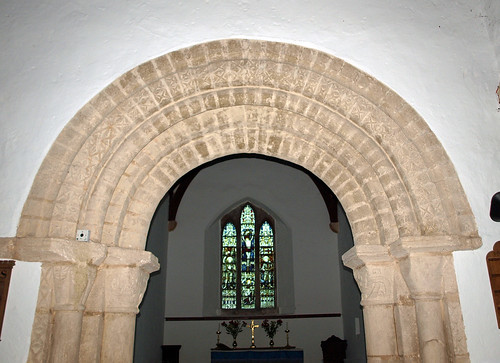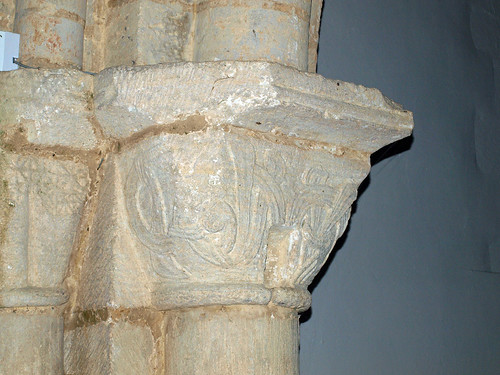ST MARY. The church has a mighty Norman chancel arch of the early C12. Capitals with interlaced bands (cf. Castor), thick rolls in the arch. Along the hood-mould and down the jambs saltire crosses, like flattened-out dogtooth. Then, still Norman, the N aisle W window, and after that, early C13, the S aisle W window and both arcades. They are of three bays and have round, double-chamfered arches. Octagonal piers. N comes before S. Some nailhead on the S side. The arches from the aisles into the transepts are contemporary. The transepts are clearly contemporary too (see the N transept N lancet), as is also the W tower with its lancets below. The curious twin rising arches to the W ending on a long mid-shaft must indicate that in the C13 a bellcote and not a tower was planned. The top stage is indeed Perp. The N porch is a puzzle. Can it also be early C13? The twin side openings still have round arches. The doorway is pointed, with slight chamfers. The entrance has nailhead. The N doorway is like the S doorway. In the S transept S wall is a three-light window with cusped intersecting tracery, i.e. of c.1300, and the N and S aisle windows of three stepped lancet lights under one segmental arch are most probably of such a date too. The chancel is c.1300 at the latest, but more probably c.127 5. It has twin lancets under one blank arch to N and S. That on the N side has in the blank tympanum a charming foliated cross, just like those on coffin lids or indeed like the ironwork on C13 doors. Re-fixed against the nave roof are men and angels probably from the roof’s predecessor. - PAINTINGS. Over the chancel arch C15 figures, hardly recognizable. - STAINED GLASS. E window by Kempe, 1901. - PLATE. Paten on foot of 1648-9; Cup, Cover Paten, and Plate of 1798-9.
HADDON. It is peace at the end of a lovely lane. We do not wonder that it has treasured fragments of its first church for 900 years. They are in a corner of the nave, a few stones in the wall that were here before the Battle of Hastings.
The Normans added a beautiful chancel arch to the Saxon church, with a row of little crosses round. The aisles with their curious transepts, and the chancel which seems to have been pushed a little to one side, are 13th century. One of the original chancel windows is unusual, its stone mullion outside having been carved with a shaft running up to a foliated cross above the two lights. The shaft has gone but the cross remains. The clerestory is 16th century. The roof of the nave has bosses carved with faces and leaves and quaint corbels of men and angels 400 years old. It is one of the churches with stone benches running round the walls; we see them in the transepts and aisles, a relic of the days when churches had no seats and the tired and weary folk went to the wall.
Two of Haddon’s old possessions have been here 500 years, one a stone lion crouching wearily at the door, the other a fragment of wall painting over the chancel arch. It was fading when we called, but Christ on a rainbow was still to be seen.
The Normans added a beautiful chancel arch to the Saxon church, with a row of little crosses round. The aisles with their curious transepts, and the chancel which seems to have been pushed a little to one side, are 13th century. One of the original chancel windows is unusual, its stone mullion outside having been carved with a shaft running up to a foliated cross above the two lights. The shaft has gone but the cross remains. The clerestory is 16th century. The roof of the nave has bosses carved with faces and leaves and quaint corbels of men and angels 400 years old. It is one of the churches with stone benches running round the walls; we see them in the transepts and aisles, a relic of the days when churches had no seats and the tired and weary folk went to the wall.
Two of Haddon’s old possessions have been here 500 years, one a stone lion crouching wearily at the door, the other a fragment of wall painting over the chancel arch. It was fading when we called, but Christ on a rainbow was still to be seen.



No comments:
Post a Comment